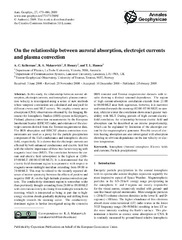On the relationship between auroral absorption, electrojet currents and plasma convection
Permanent lenke
https://hdl.handle.net/10037/2386Dato
2009-02-02Type
Journal articleTidsskriftartikkel
Peer reviewed
Sammendrag
In this study, the relationship between auroral absorption,
electrojet currents, and ionospheric plasma convection
velocity is investigated using a series of new methods
where temporal correlations are calculated and analysed for
different events and MLT sectors. We employ cosmic noise
absorption (CNA) observations obtained by the Imaging Riometer
for Ionospheric Studies (IRIS) system in Kilpisj¨arvi,
Finland, plasma convection measurements by the European
Incoherent Scatter (EISCAT) radar, and estimates of the electrojet
currents derived from the Tromsø magnetometer data.
The IRIS absorption and EISCAT plasma convection measurements
are used as a proxy for the particle precipitation
component of the Hall conductance and ionospheric electric
field, respectively. It is shown that the electrojet currents are
affected by both enhanced conductance and electric field but
with the relative importance of these two factors varying with
magnetic local time (MLT). The correlation between the current
and electric field (absorption) is the highest at 12:00–
15:00MLT (00:00–03:00MLT). It is demonstrated that the
electric-field-dominant region is asymmetric with respect to
magnetic-noon-midnight meridian extending from 09:00 to
21:00MLT. This may be related to the recently reported absence
of mirror-symmetry between the effects of positive and
negative IMF By on the high-latitude plasma convection pattern.
The conductivity-dominant region is somewhat wider
than previously thought extending from 21:00 to 09:00MLT
with correlation slowly declining from midnight towards the
morning, which is interpreted as being in part due to highenergy
electron clouds gradually depleting and drifting from
midnight towards the morning sector. The conductivitydominant
region is further investigated using the extensiveIRIS riometer and Tromsø magnetometer datasets with results
showing a distinct seasonal dependence. The region
of high current-absorption correlation extends from 21:00
to 06:00MLT near both equinoxes, however, it is narrower
and rotated towards the morning (02:00–07:00MLT) in summer,
while in winter the correlation shows much greater variability
with MLT. During periods of high current-electricfield
correlation, the relationship between electric field and
absorption can be described as an inverse proportionality,
which can be explained by limitation of the electrojet current
by the magnetospheric generator. Possible cases of electron
heating absorption are also investigated with absorption
showing no obvious dependence on the ion velocity or electron
temperature.
Beskrivelse
This is the publisher’s version/PDF (Published in Annales Geophysicae, an open access journal of the European Geosciences Union)
Forlag
Copernicus Publications on behalf of the European Geosciences UnionSitering
Annales Geophysicae, 27, 473–486, 2009Metadata
Vis full innførselSamlinger
Følgende lisensfil er knyttet til denne innførselen:


 English
English norsk
norsk